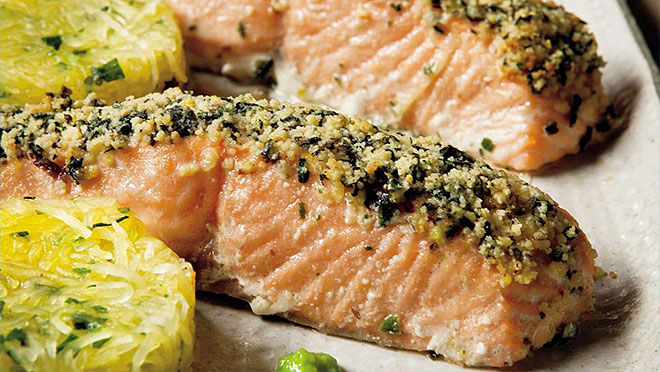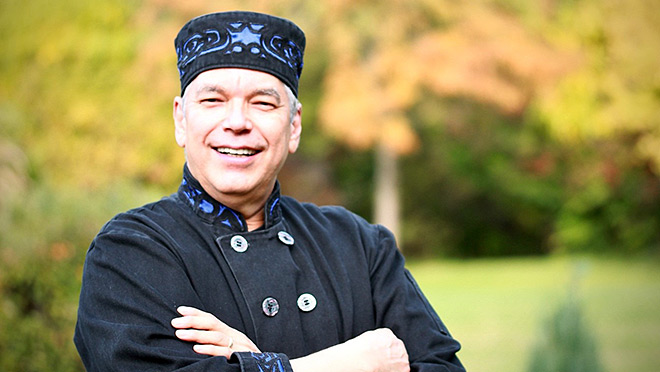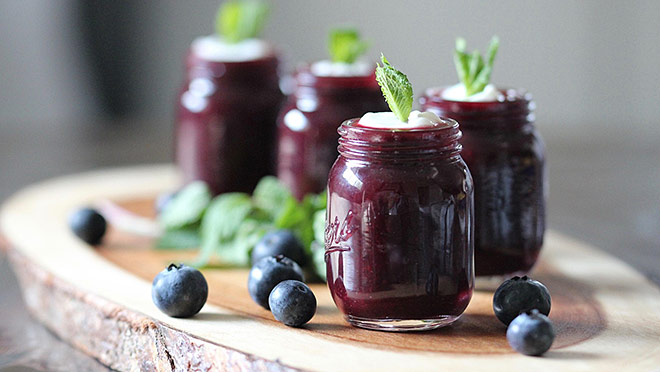Indigenous chef riffs on salmon, maple water, and pressure cooking

Editor's note: We recognize the timing of this publication coincides with the tragic news of a burial site found at the former Kamloops Indian Residential School. This devastating situation is a stark reminder that the legacy of the residential school system persists today. We're able to celebrate Indigenous culture and discuss important topics like the ones in this piece because of the strength and resiliency of residential school survivors and Indigenous peoples. We also acknowledge the past and current impacts of BC Hydro's operations on Indigenous Nations in B.C., and are committed to honouring Indigenous perspectives and values as we move forward.
David Wolfman digs into his Indigenous B.C. roots for delicious spins on classics
As chef professor at George Brown College's Centre for Hospitality and Culinary Arts, David Wolfman will often tell his students to resist relying on what's in a cookbook.
"If you try to remember everything in a cookbook or a textbook, you won't," says Wolfman, on a Zoom call from his kitchen in Toronto for a discussion in advance of National Indigenous Peoples Day on June 21. "Think as a chef. Think about what works."
He then goes on to explain how he developed his Xaxli'p salmon recipe, named for the Lillooet B.C.-area First Nation his mom was from and which he visited to catch up with relatives and to explore Indigenous cooking. It's a departure from the norm in that it uses pine nuts and seaweed as a crust, and it's typical of the Indigenous-fusion approach that brought him fame as host of the Cooking With the Wolfman TV series that debuted on Aboriginal Peoples Television Network (APTN) in 1999.
"I wanted something crispy, wanted something to stick on top of the fish," he says. "But everything you put on falls off, so I came up with a little bit of egg white brushed on there, and when it cooks, it acts like a glue. It coagulates and firms it up. And then I thought pine nuts would be nice. You can use pine nuts, cashews, almonds, almost any nut. And then I thought to add some sort of seaweed. There's a winged kelp, or bull kelp, you find off the coast of Vancouver Island. People want things that are juicy, fatty, and crispy, with a bit of texture. And seaweed gives it that salt flavour. And it needs a bit of spice, so I use the Dijon mustard, plus a bit of maple syrup in there, to help create that full flavour.
"It's food science."
What's on the menu for this piece? The full Xaxli'p salmon recipe (below), a celebration of seasonal and local produce, and a look at one of Wolfman's summer faves, the Into The Woods Smoothie.

You can cook with a pressure cooker, but watch that timing
At BC Hydro, we like to encourage the use of energy efficient small appliances, especially as a means of keeping the kitchen cool during the summer. So we had to ask Wolfman if he was a fan of the pressure cooker – popularized by the rise of the Instant Pot – for certain dishes.
Yes, he said, but watch that cooking time, and innovate. He likes it because it saves on cooking time and is fantastic for blending flavours.
"We cook beets in our pressure cooker, and it takes maybe 45 minutes where it used to cook for five or six hours on the stove," he says. "Pressure cookers are fast, and you'll have something that's juicier. And meats like elk or caribou curries are nice in a pressure cooker, too."
Wolfman said he also discovered that, if you cook something that leaves a lot of liquid behind, you can leave the top off the pressure cooker, turn on the sauté function, and thicken the sauce.
The key is to not overcook the ingredients. Asked if it would be wise to use a barbecue instead of the oven for his Xaxli'p baked salmon recipe – using a grill helps avoid heating up the kitchen on a hot day – he offers advice on how to get it right.
"You can use the grill for that recipe, but heat it at a bit of a lower temperature," he says. "You might want to do it in the upper part of the grill, maybe even in a cast iron frying pan. You don't want the heat too high, or it will dry out the fish."
What the seasons mean to an Indigenous chef
It's berry season, and Wolfman loves them – check out his Wild Blueberry Scone [PDF] and his Berry Trifle [PDF]. He says his visits to the Xaxli'p helped him to better understand how closely the seasonality of food is linked to Indigenous culture.
He explained that when the buttercup arrives in the spring as an orange, pinkish colour, it's taken as an "ecological indicator" telling us that it's time to start catching salmon.
"And after we'd gut the salmon, we'd bury it in the sand – which was still very cold, near the water in the Fraser River," he says. "We'd take all the innards into the woods for the bears, because if we didn't share that, they'd come and find our salmon. We knew that we weren't alone, and that we needed to respect that."
He recalls that the spring salmon run was signalled by the arrival of a bright red rose. And as the day warmed up and grasshoppers started rubbing wings together to make a clicking sound, it was time to retrieve the buried salmon.
"That's a sign that it's now hot enough out to wind-dry the salmon," he says. "And that clicking sound was the same as the sound of us cutting the backbone of the salmon."
Wolfman laughs at his first (and failed) attempt to visit the Xaxli'p territory, as a guy growing up in a big city, and discovering too late that snow had blocked one route to the Lillooet area, and an avalanche blocked an alternate route. When he finally got there in 1983, after his mother's passing, he was greeted by locals constantly offering him salmon ("they heard I loved salmon").
His uncles didn't want to talk salmon, however. They knew he was classically trained in French cooking, and wanted to learn how to make a great Hollandaise sauce.
Indigenous People's Day, and giving thanks every day
Asked what National Indigenous Peoples Day means to him, Wolfman reminisced about a discussion he once had with his mom around another day on the North American calendar – Thanksgiving Day.
"At Thanksgiving, I'd say to my mom that we're supposed to give thanks this weekend," he said. "And she tells me, 'we don't wait for one day. We do this all the time. Why would we wait for one day?"
For Wolfman, that thanks – and the sharing of food and traditions – is a way of life in Indigenous culture. He says it makes Indigenous people question how they eat, how they shop, and whether they're wasting food.
"And are we sharing with our neighbours?," he asks. "When making food, I bring it to my neighbours. One of my friends once asked me 'Why do you do that? Doesn't your neighbour already have a lot of food?"
"I told him 'Yes', but sharing is just something my mom taught me."

Maple water as the key ingredient in a smoothie
The BC Farmers Market What's in Season calendar provides more guidance on when berries and other produce are ripe for the picking in regions around B.C. By the time National Indigenous Peoples Day rolls around, we'll be well into berry season – at least in the Okanagan – with strawberries, cherries, saskatoon berries, and blueberries all likely to be available. So why not try Wolfman's twist on the classic blueberry smoothie?
The Into The Woods Smoothie (recipe below) mixes in pecans, avocado, a bit of maple syrup, sunflower seed butter and equal parts blueberries and maple water.
Maple water?
"It's fantastic," he gushes. "People relate it to coconut water, but I think it has fewer calories, and a bunch of minerals in there. This is what comes straight out of the tree, before it's processed into syrup. So it doesn't have that thickness or sweetness."
Yum.
Xaxli'p Salmon recipe
(Serves six)
Ingredients
- 4 coho salmon fillets (each 4 oz/120 g), skin on
- ½ teaspoon (2.5 mL) crushed black peppercorns
- ½ teaspoon (2.5 mL) smoked paprika
- ½ teaspoon p (2.5 mL) smoked sea salt
Crust
- 1 cup (250 mL) crushed breadcrumbs
- 2 tablespoons (30 mL) dried seaweed, chopped fine
- (preferably purple laver)
- 1 tablespoon (15 ml) pine nuts, roasted and chopped
- (or almonds)
- 1 teaspoon lemon zest
- ¼ teaspoon (1 mL) coarse salt
Glaze
- 2 egg whites
- 2 tablespoons (30 mL) butter, melted
- 2 teaspoon (10 mL) Dijon mustard
- 1 tablespoons (15 mL) maple syrup
- Optional: sprig of fresh cedar and/or
- sea asparagus for garnishing
Preparation
Preheat oven to 375°F (190°C).
Season the salmon with the pepper, paprika and salt on a parchment-paper lined baking sheet or cast iron pan and let stand for 30 minutes. In a blender, combine the bread crumbs, seaweed and nuts. Pulse a couple of times. Add the lemon zest and coarse salt.
Prepare the glaze for the salmon by whisking together the egg whites, mustard, butter and maple syrup in a small bowl. Brush glaze over the top of each piece of salmon.
Evenly coat the top of each salmon fillet with the seaweed crust.
Bake fish for 10 to 15 minutes, depending on the thickness of the fillets. (A good rule of thumb is to bake for 8 minutes per inch of thickness at the thickest part of the fish.)
Serve hot with a garnish of fresh cedar.
Into The Woods Smoothie recipe
This is a quick recipe for a tasty smoothie featuring ingredients indigenous to Turtle Island. Maple water is what you get when you tap maple trees, and it can be found in health food stores.
Ingredients
- 1 cup (250 mL) fresh or frozen blueberries
- 1 cup (250 mL) maple water
- 1 ripe avocado
- ¼ cup (60 mL) pecans
- 1 tablespoon (15 mL) maple syrup
- 2 tablespoon (30 mL) sunflower seed butter
Preparation
Combine all ingredients in a blender, and blend until smooth. Makes two servings.
Related links: